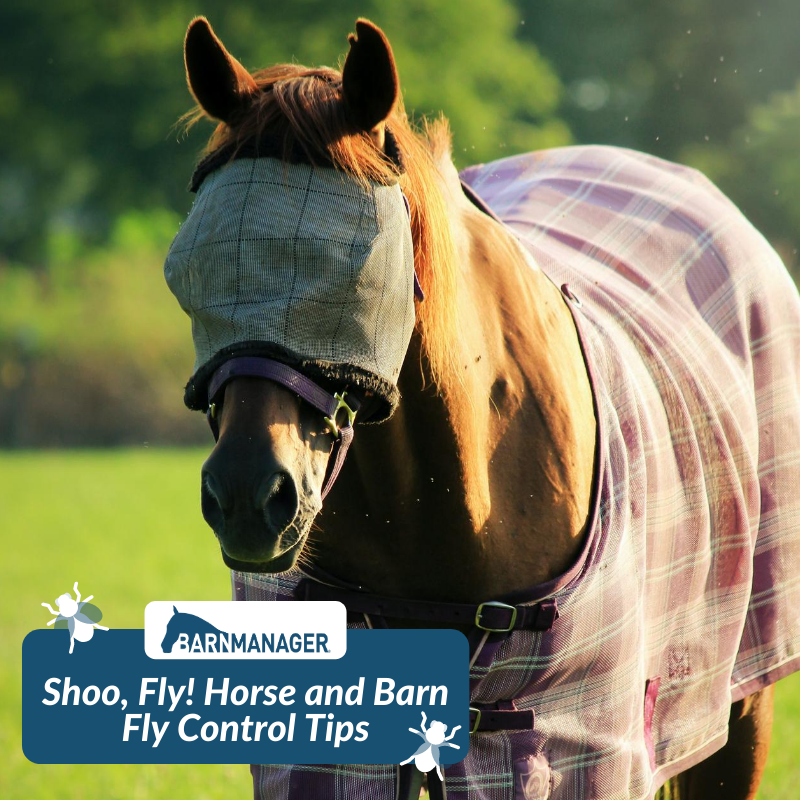
Shoo, Fly! Horse and Barn Fly Control Tips

There are few certainties in life but death, taxes – and flies at the barn. Beyond simply being a pest to both you and your horses, flies can carry diseases, cause sores or keep wounds from healing properly on your horses, and they can even cause injury to horses’ feet or legs from persistent stomping.
Fortunately, there are a large number of ways to combat flies and reduce their presence, you just need to have a plan and the right tools in your arsenal. We’ve broken down a number of best tips and practices into three categories: prevention, barn fly control and on-horse options.
Prevention
General cleanliness and good manure management are the first steps in battling flies.
Your horses’ manure is prime fly habit and often where the flies reproduce, so it’s also the best place to stop flies right where they start. Keeping stalls picked frequently is the first step, but you’ll also need to consider where manure goes after that point.
If you’re able to do so, spreading the manure is the best solution, as this breaks up and dries out the flies’ home. When spreading manure, be sure to do so thinly (generally less than half an inch thick) so that it dries out quickly and doesn’t inadvertently create an even larger fly breeding ground.
If you are not able to spread manure, do your best to ensure that your manure pile is situated well away from the barn. You can help the pile to decompose more quickly by working it with a pitchfork regularly to introduce oxygen. Maximizing the heat of the manure pile also helps with its break down and can make it too hot to allow flies to lay their eggs. Covering the manure pile with a dark plastic tarp or barrier not only creates an additional physical barrier, it can further aid in increasing the pile’s heat and killing the larvae.
In addition to manure, piles of grass clippings or leaves or standing mud or water can also encourage increased flies so should be dealt with accordingly. Other general cleanliness and management tips include: keeping grass cut short so that flies are unable to rest on the grass, removing moisture and puddles that often form around water troughs and tanks, frequently cleaning out feed buckets so that the flies aren’t drawn to the crumbs and utilizing fans to circulate air, which makes it more difficult for flies to navigate to your horses.
Barn Fly Control
The most common options for around-the-barn fly control are traps and misters. Pyranha makes a popular misting system, and Country Vet Dispenser offers an easy-to-use, battery-operated option.
When it comes to traps, it can be helpful to know what kind of flies you’re dealing with. Biting stable flies, including horse flies, are generally visually attracted to traps, while house flies are drawn to traps by their odor. This Starbar Trap N Toss Fly Trap is best suited for stable flies, while this one is targeted toward house flies.
Trapping, using either jars filled with an attractant like those mentioned, or sticky fly paper, can be one of the most effective ways to battle adult flies, but the traps may need to be used liberally. Consider trying out various locations for your traps to see which spot catches the most flies.
In more recent years, fighting bugs with other bugs has become an increasingly popular option as well, particularly for horse owners leery of utilizing chemicals around the barn. Fly predators, such as tiny wasps that do not sting animals or humans, kill flies in their early developing stages. You can learn more about purchasing and utilizing fly predators here. Many companies will also work with you to customize a system and fly-control program that is right for your barn.
On-Horse Options
When it comes to options for use directly with your horse there are three main categories: topicals, feed throughs and physical barriers.
Topical options come in a variety of forms including ointments, sprays, wipes, spot applicators and more. When considering your options, it can be helpful to take a look at the ingredients. Many products contain permethrin, pyrethrin or a combination of the two. Permethrin is lethal to flies and will kill them after they land on an area treated with the fly spray or ointment. Pyrethrin acts as a fly deterrent, aimed at keeping the flies from landing on your horse. You may also want to consider all-natural options like this one, or try making your own following a recipe like this one. (Bonus: have you seen this handy fly spray application tip?)
When it comes to physical barriers preventing flies from getting to your horse, fly masks and sheets are the most common choices, and some elect for fly wraps as well.
Feed throughs, such as this one from SmartPak and this one from Farnam, are designed to kill the fly larvae and are most effective when started early in the spring to fend off flies before they are an issue. If you are starting to use a feed-through option later in the season, you may also need to employ other fly-fighting methods, as the feed-through supplements will not help combat the adult flies that may already be present.
With a combination of the aforementioned combatants, you should be ready to help ban bugs from your barn! Good luck, and happy fly hunting!